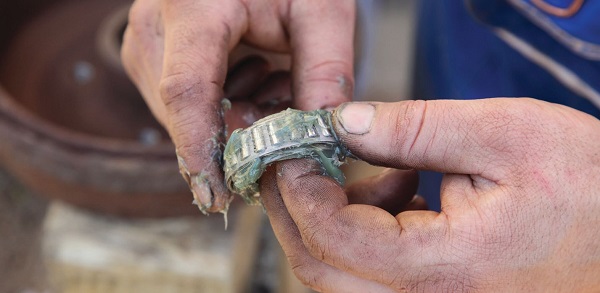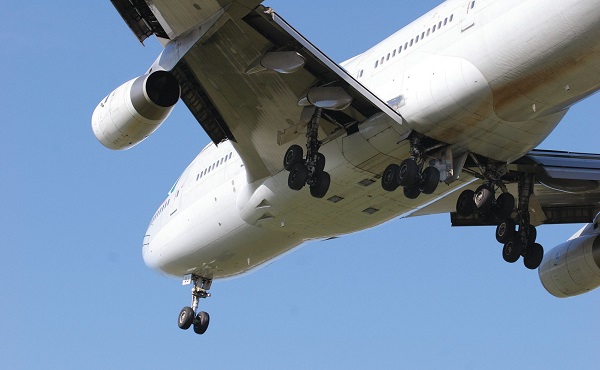The problem with judging tackiness
Andrea A. Aikin Contributing Editor | TLT Grease March 2020
Researchers seek a quantitative method to help formulators make better decisions.

There is no way to judge a grease’s tackiness before the end-user tries it.
Greases are used in a number of different industrial fields, ranging from construction, mining and transportation to the food industry. The purpose of using greases in these different applications is to reduce frictional forces to protect industrial components from wear and corrosion. As a semi-solid, a grease is better able to adhere to a metal part than an oil. Grease performance hinges on the interaction of different properties, including adherence to the substrate material (i.e., adhesivity), cohesion and tackiness.
Identifying the appropriate grease for a given application can be challenging as there is no established quantitative method that accurately measures the grease tackiness. A grease can have too much or not enough tack for a particular project. Tackiness is defined as the cohesiveness or stickiness of a material. Words like glueyness, ropiness and viscosity are used to describe the resistance of a liquid to flow or shear. Properties like apparent viscosity, resistance to oxidation and structural and mechanical stability also can indicate whether a grease is suitable for a particular application.
STLE-member Erik Willett, technical director at Functional Products Inc. in Macedonia, Ohio, identifies three things the grease market currently lacks:
• A way to know how tacky a grease is before customers try or buy it.
• A test method to reproducibly QC tackiness for each batch of grease.
• A way to correlate and optimize both the obvious and subtle effects of tack to a specific application.
While instrumentation companies such as Falex, Koehler and others are working toward reproducibly measuring grease tackiness, Willett notes, “A simple and informative number for both formulators and end-users to make informed decisions on the tackiness of a grease is still in the future.”
 Researchers are seeking ways to standardize grease tackiness and test procedures.
Working with grease
Researchers are seeking ways to standardize grease tackiness and test procedures.
Working with grease
STLE-member Anoop Kumar, a senior staff scientist with Chevron Inc. in Richmond, Calif., states, “Measuring the tackiness of grease is often perceived as a significant screening criterion in the selection of grease.” While no standard test methods are currently available to reproducibly measure tackiness, Kumar notes that efforts are being made to “quantitively measure the tackiness of greases and standardize the tests.”
NLGI publishes an NLGI consistency number that expresses a measure of the relative hardness of a grease used for lubrication. NLGI’s classification is reproduced in ASTM D4950 (Standard Classification and Specification of Automotive Service Greases)
1 and SAE J310 (Automotive Lubricating Greases).
2 However, the NLGI consistency number alone is not adequate for specifying the grease a particular application requires.
When discussing grease tackiness, ASTM D2979 (Standard Test Method for Pressure-Sensitive Tack of Adhesives Using an Inverted Probe Machine)
3 may be mentioned. Tack is a measure of the force needed to separate the adhesive and the adherent at their interface shortly after they have been brought into contact under a defined load of known duration at a defined temperature. While this particular ASTM method is used to measure adhesion, it is not appropriate for measuring the tackiness of grease.
Several perception-based qualitative approaches are currently used to measure grease tackiness. These include a test colloquially known as the fingertip or spatula test. Kumar describes the test as placing a blob of grease between the thumb and index finger. The thumb and index finger are then pulled apart until the string of the grease breaks.
Kumar says, “The distance and force required to separate them determines the extent of tackiness of the particular grease.” However, this test is highly variable depending on the person performing it. Currently, there are no standard test methods to numerically measure the tackiness of greases, although work is occurring to develop such tests. This developmental work is focusing on the same principle as the fingertip/spatula test.
John Sander, vice president of technology at Lubrication Engineers, Inc., in Wichita, Kansas, notes, “A quantitative number has not been really necessary.” End-users often like the eye candy effect of placing a grease sample between their finger and thumb and watching it string, although many have found these results do translate into performance in the field. Impact tests also are used to assess tackiness, but these also lack a numerical result. No standard test method reproducibly measures grease tackiness.
Potential measurement methods
A 2019 Tribology Transactions paper titled Development of Grease Tackiness Test discusses how a test method using a standard tribometer was able to differentiate different greases.
4 A tribometer measures tribological quantities between two surfaces that are in contact, including the coefficient of friction, friction force and wear volume. The article notes that “working” the grease before conducting the test has a significant impact on grease tackiness. While the specific test method described in the article was shown to provide similar results to more expensive and time-consuming tests, it is not generally accepted in industry.
Willet adds, “Equipment is being developed to quantify tackiness by pulling threads of grease with a probe and measuring the thread length at the breaking point.” This is similar to the process of measuring string length in oil with the ductless siphon test.
Willett notes, “Grease polymers all impart different ‘types’ of tackiness to grease. Some greases become very stringy, others have more of a tough impact-resistant quality to them, and some polymers might have no discernable tackiness but improve stability in water spray off and worked-cone penetration.” It would be useful to have a system capable of classifying these different types of tackiness for different applications.
 Quantifiable data
Quantifiable data
A 2018 article in the peer-reviewed journal Tribology Letters notes that tackiness of industrial greases is not a single value as tackiness changes with experimental conditions.
5 However, it might be possible to develop a map of grease tackiness with respect to changing experimental or working conditions (e.g., retraction speed, grease film thickness, applied load, temperature, etc.).
Functional Products collaborated with the Falex Corp. in Sugar Grove, Ill., to develop the Falex Tackiness Adhesion Analyzer (TAA). The device quantitatively measures the tackiness and adhesion properties of both greases and other lubricating materials by executing and recording scientifically determined values related to measuring tackiness, including pull-off force, separation energy and retraction speeds. These values are used to calculate the tackiness number, which is calculated by dividing the thread length by the separation energy.
The Falex TAA device can be used to profile grease tackiness with respect to changing temperature and retraction speed. The device’s goal is to replace the fingertip test by directly measuring adhesion, tackiness and thread length under unique test conditions. Falex believes this number has application in grease specifications and will permit complete characterization with respect to tackiness.
Conclusions
Currently customers evaluate tackiness subjectively by testing to evaluate the effectiveness of a particular grease for a specific application. While this process addresses an immediate problem, it doesn’t create a clear path forward for future work.
Ultimately, developing a tackiness number that could complement the NLGI consistency grade would allow both formulators and end-users to make more informed decisions.
Andrea R. Aikin is a freelance science writer and editor based in the Denver area. You can contact her at andrea.r.aikin@gmail.com.
FURTHER READING
• For more information on a preliminary study of the development of a grease tackiness test, see the article in Tribology Transactions.
• For information on a new methodology based on approach-retraction curves that seeks to objectively measure adhesion and tackiness in industrial greases, see the article in Tribology Letters.
REFERENCES
1. ASTM D4950-19, Standard Classification and Specification for Automotive Service Greases, ASTM International, West Conshohocken, PA, 2019, available
here.
2. SAE International. J310 Automotive Lubricating Greases.
3. ASTM International. (2001), ASTM D2979-01, Standard Test Method for Pressure-Sensitive Tack of Adhesives Using an Inverted Probe Machine,
Annual book of ASTM standards 2001, West Conshohocken, Pa.: American Society for Testing and Materials.
4. Harmon, M., Powell, B., Barlebo-Larsen, I. and Lewis, R. (2019), “Development of Grease Tackiness Test”
Tribology Transactions,
62 (2), pp. 207-217. Available
here.
5. Georgiou, E.P., Drees, D., De Bilde, M. and Anderson, M. (2018), “Can We Put a Value on the Adhesion and Tackiness of Grease?”
Tribology Letters,
66 (2). Available
here.